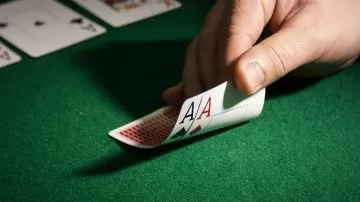Back Raise in Poker
In the world of poker, understanding the vast array of tactics and maneuvers is crucial for any player looking to dominate the game. Among these is the term back raise, which refers to a particularly tricky move. A back raise occurs when a player first calls in a betting round, but then raises after another player’s subsequent bet. This move is usually used as a deceptive strategy to hide the strength of a player’s hand and get more chips in the pot from opponents who may be fooled by a false sense of security.
The effectiveness of the back raise lies in its ability to disrupt the game and confuse opponents. It is a testament to a player’s skill in both psychological warfare and strategic planning, requiring a keen understanding of timing, hand reading and game dynamics. This maneuver is not only related to the cards in the hand, but also to the signal it sends to the table.

Now let’s give you an example of back raise from our own practice.
Let’s look at a high-stakes Texas Hold’em poker game to illustrate the usefulness of the back raise. The game is played at a table with experienced players, each of whom is skilled in the complex dance of bluffing and counter-bluffing that characterizes elite poker play. In this scenario, Player A has a pair of jacks (J-J), a strong but vulnerable hand. On the flop, A-J-4 comes up, giving Player A a set, but also posing a potential threat of higher sets or straights to wary players.
As the action progresses, player B, seated to the right of player A, makes a moderate bet after the flop. Player A, deciding not to reveal the strength of his set immediately, calls, inviting further bets. Player C, sensing an opportunity and unaware of Player A’s strong hand, raises significantly, trying to capitalize on the moment of weakness.
Player A now raises back, re-raising a significant amount over Player C’s bet. This move serves several strategic purposes: not only does it increase the value of the pot, given Player A’s strong hand, but it also sends a confusing signal to the rest of the game. Player B and Player C are now caught off guard and forced to reconsider their hands and strategies. They are faced with a dilemma: fold and save their stacks or call and take the risk that Player A’s reverse rake has created.
In this case, Player A’s counter-raise was not simply a reflection of the strength of the hand, but a carefully considered move designed to manipulate the dynamics of the game. This case illustrates how a counter raise, when used wisely, can be a powerful weapon in a poker player’s arsenal, turning the tide of the game and leading to significant psychological and financial advantages.
You can also listen to the audio version of the page.
Implementing a Back Raise Strategy
In my poker experience, mastering the art of the back raise was a turning point that allowed me to utilize my position and hand strength in ways that were not immediately obvious to my opponents. The back raise is a tricky maneuver that is best used in situations where the table dynamics and my opponents’ tendencies align, creating a favorable opportunity to execute it.

I have found that the most opportune times to use reverse raises are when I have a strong but not unbeatable hand in hand, and the action ahead of me indicates that other players are testing the waters with moderately strong hands or bluffs. For example, in no-limit Texas Hold’em, if I’m sitting with a hand like two pair or set after the flop, and there is an initial bet from my opponent followed by a raise from another player, that’s my signal. An initial call on my part serves two purposes: it lulls my opponents into a false sense of security and it encourages further action that can increase the pot.
Moreover, timing and positioning are crucial. Being in late position, I have the advantage of seeing how others act before making my move. A reverse raise from this perspective can put maximum pressure on my opponents, forcing them to make difficult decisions in the face of incomplete information.
However, reverse promotion is not without risk. It requires a keen sense of judgment and timing. Overuse or misuse of this strategy can lead to predictability, allowing shrewd opponents to exploit my attempts at deception. Thus, caution and a thorough understanding of table dynamics are paramount.
Countering Back Raise
As much as I pride myself on executing a back raise, facing it can be a challenge. Over time, I have developed strategies for countering back raises, understanding when to engage and when caution is the better part of valor.
The first step in countering a counter raise is to carefully evaluate the raiser’s tendencies and the range of hands he may have in hand. A player known for his aggressive play may use a reverse raise with a wider range of hands, including bluffs, while a reverse raise from a more conservative player is likely to indicate a strong hand.
One effective counter-strategy is to narrow my range. If I am faced with a return raise and I have a hand that is on the verge of strength, it is often wise to fold and save my chips for a more favorable situation. Going all-in without a clear advantage can be a costly mistake.
However, there are times when a direct response to a back-raise can be advantageous, especially if I have a premium hand or if table dynamics suggest that the back-raiser is trying to exploit a perceived weakness. In such cases, a re-raise or “3-bet” can be a powerful counter move that forces the original raiser to make a tough decision.
It is also important to recognize situations in which a counter raise is not appropriate. If the pot is already large and my hand is not strong enough to confidently counter a potential all-in scenario, preserving my stack and waiting for a better time becomes paramount. Understanding when to refuse a retaliatory raise is just as important as understanding when to execute it.
Both executing and countering a counter raise are a complex part of advanced poker strategy. They require not only a deep understanding of the mechanics of the game, but also a keen perception of opponents and situations. Like a chess master planning several moves ahead, an experienced poker player must navigate these strategic waters using foresight, precision, and the occasional bold gambit.

